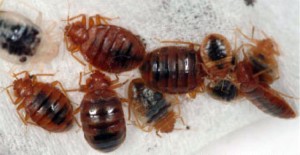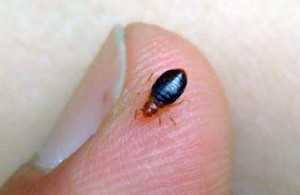 They’re all over the news these days, not to mention in the frames of beds, mattresses, pillows and on the floor boards. Yes, bed bugs have made a big comeback. Interestingly, no one seems to really know why this is so, although there are a few theories. Clinics and emergency rooms have seen increases in the numbers of people complaining of bites and bringing in teeny tiny little reddish-black bugs in plastic baggies.
They’re all over the news these days, not to mention in the frames of beds, mattresses, pillows and on the floor boards. Yes, bed bugs have made a big comeback. Interestingly, no one seems to really know why this is so, although there are a few theories. Clinics and emergency rooms have seen increases in the numbers of people complaining of bites and bringing in teeny tiny little reddish-black bugs in plastic baggies.
Bed bugs are found all over the world. It seemed for a while, back in the 1950s when pesticides like DDT were used, that bed bugs had died out, at least in the United States. They were still found in other parts of the world, but much less than previously. They live in bedding, bed frames, box springs, mattresses, floor boards, carpeting, cracks, crevices, behind wallpaper, in night stands, you name it – they can live there. Amazingly, they can survive without having a meal of blood for months to a year. Bed bugs probably sense warmth and carbon dioxide given off by people. They like to hang around where people sleep, so hotels, dorms, shelters, and, of course, houses and apartments are all good lodging as far as a bed bug is concerned. It’s likely, then, that bed bugs find a nice, cozy spot in a suitcase and travel where people travel and then set up headquarters there. No matter how clean you are, you can still have bed bugs.
Bed bugs stay alive by feeding on both human and animal blood, usually enjoying their tasty meals at night. An anesthetic is injected by the bed bug while it’s biting, so the person doesn’t actually feel it at the time it is happening. Sometimes it can take up to two weeks for people to react to their bites (they wake up in the morning with some red dots that are itchy), and by that time, the infestation may be huge and hard to get rid of.
 If there is any good news about this re-emerging epidemic of bed bugs, it is that there are no documented cases of them causing disease in humans. It doesn’t mean, though, that bed bugs are not a public health menace. Some people may find that they are allergic to the bed bug, just as they are allergic to dust, pollen, mosquito bites, etc. While most folks will get some redness, itching and swelling around the bites, if they are allergic it will be worse and some will develop anaphylaxis, a very serious and potentially deadly reaction that causes trouble with breathing and shock.
If there is any good news about this re-emerging epidemic of bed bugs, it is that there are no documented cases of them causing disease in humans. It doesn’t mean, though, that bed bugs are not a public health menace. Some people may find that they are allergic to the bed bug, just as they are allergic to dust, pollen, mosquito bites, etc. While most folks will get some redness, itching and swelling around the bites, if they are allergic it will be worse and some will develop anaphylaxis, a very serious and potentially deadly reaction that causes trouble with breathing and shock.
One of the theories as to why we seem to be having a bed bug epidemic now is that the bugs have become resistant to the pesticides used on them. The weak bugs die but the fittest live, and something changes in them so that the pesticide cannot kill them (survival of the fittest). When homes and apartments were routinely being sprayed with pesticides like DDT, the bugs just couldn’t take the pace and died. DDT and other pesticides were banned from use, however, because it was discovered that they cause health problems in humans.
There have been reports of bed bugs in some of the world’s finest hotels, so no one is safe. The first thing to do if you’re on the road and sleeping where other people have slept before (like in a hotel bed), is to check the sheets, mattresses, carpets, etc. for any exoskeletons (the part that sheds when the bed bug molts). Also, look for brownish-red material on sheets. You need to check everywhere – headboards, mattresses, bed frames, chairs, etc. Bed bugs like to hide during the day, so you have to really look for them. And, since they are shy about being in the light, you need to especially check out the dimly-lit places. If you do see evidence of bed bugs, ask for another room at a distance from the infested one. You should also report the situation to the hotel management.
 Here are some other tips for avoiding bed bugs while staying in a hotel. Don’t put your bags down on the floor – at least you might make it a little more difficult for the bugs to get into them. If possible, leave them in the bathroom (provided there aren’t other nasty critters you want to avoid in there). When you get home, wash and dry your clothes with the hottest water and highest heat settings you can. Vacuum out any containers you had in the room with you and put the contents of the vacuum cleaner into a sealed plastic bag when you empty it. Unfortunately, insect repellents such as those sold to keep mosquitoes and ticks away, don’t seem to have any effect on bed bugs.
Here are some other tips for avoiding bed bugs while staying in a hotel. Don’t put your bags down on the floor – at least you might make it a little more difficult for the bugs to get into them. If possible, leave them in the bathroom (provided there aren’t other nasty critters you want to avoid in there). When you get home, wash and dry your clothes with the hottest water and highest heat settings you can. Vacuum out any containers you had in the room with you and put the contents of the vacuum cleaner into a sealed plastic bag when you empty it. Unfortunately, insect repellents such as those sold to keep mosquitoes and ticks away, don’t seem to have any effect on bed bugs.
If you realize, in spite of all your caution, that there were bed bugs in your room, you can report your findings on www.bedbugregistry.com – a website created to help keep track of where bed bugs are found and encourage management of such establishments to have their rooms treated to get rid of them. If you do get bitten, it’s super important not to scratch. You can use over-the-counter creams for the itching, which helps to soothe the discomfort. If you simply cannot fight the urge to scratch, just rub the area lightly with your fingertips, not your nails, to prevent breaking the skin and causing an infection. Remember, the more you scratch, the more you itch. That’s just so unfair, isn’t it?
So, like the old saying goes, “Sleep tight and don’t let the bed bugs bite!” The sleep tight part comes from the days when people didn’t have box springs but only ropes to support their mattress. With weight and stress on the ropes, they stretched and sagged and one did not get a good night’s sleep until the ropes were tightened up. And the bed bug part – well, you get that by now. Happy bug-free trucking!
